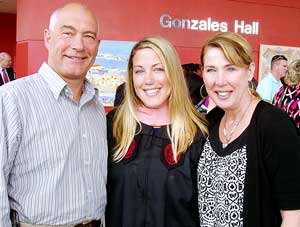Cleft palate is a deformity that strikes one in every 700 births
August 10, 2009

Lauren Hartnagel’s parents, Bill and Karen
are on hand for a graduation photo
at USC’s Koger Center
Lauren Hartnagel didn’t expect one of those “small world” moments on her first day on the job this summer.
After all, she was focused on beginning a 10-week speech pathology externship, the final academic requirement for her master’s in speech pathology from the Arnold School’s Department of Communications Science and Disorders.
As she entered the Cleft Palate-Craniofacial Center at Long Island’s Stony Brook University Medical Center, she saw a familiar face - one of the surgeons - trying to make eye contact.
“He was trying to figure out who I was, when he finally tapped his forehead, came over and said, ‘What are you doing here!?’” she recalled laughing.
It turns out the surgeon, and others on the center’s staff had reason to recognize the young woman. Over some 15 years and numerous surgeries they had seen her face change from that of a 10-week-old infant with a cleft palate to the face of a poised young woman.
“I was born in 1985, the year the clinic first opened,” said Hartnagel. “Many of the people who started then are still on the job.
Fifteen people currently serve on the Cleft Palate-Craniofacial Center staff and all of them have a role in correcting a deformity that strikes one in every 700 births. Surgeons often get the lion’s share of the credit, but other specialists weigh in with important contributions.
Speech Pathologists, like Hartnagel, are on hand to assess speech and feeding problems caused by the abnormality.
Her parents, Bill and Karen Hartnagel, were concerned about their infant daughter, but they had confidence in the Stony Brook medical team and decided early-on to raise her “just like a normal kid,” Hartnagel said.
Normal, as it turned out, involved nine surgical procedures by the time she was sixteen, braces from age five to 14 and monthly trips to the orthodontist,” she said.
Fortunately, much of her medical care was nearby. Stony Brook Medical Center is about six miles from the Hartnagel home in Port Jefferson on the north shore of Long Island.
Hartnagel said her own experiences enabled her to empathize with young people and cleft lip/palate in particular. “I can relate to these kids and I know how they feel,” she said.
At first she decided that teaching was her career choice and settled on the College of Education at James Madison University in Harrisonburg, Va. Then, sometime early on, she found her way into a class on speech pathology and realized she’d found her calling.
Switching majors, she turned to the school’s Department of Communication Sciences and Disorders, graduating in 2007. Realizing that she needed a master’s degree to reach her career goals, she then selected USC “where I’ve received a wonderful education. It was definitely where I should have been.”
She finished her externship on July 24 and currently is on a well-earned, but somewhat anxious break.
“I have (employment) applications out all over the country but now is not an easy time to find a job,” she said. She’s looking for a speech language- pathology position in an acute care hospital setting.
With six years of education below the Mason-Dixon line, Hartnagel has developed a drawl and a fondness for things southern-fried. “My friends all make fun of my accent, but that’s okay,” she said, confessing that if she ever has her choice of places to live, “I would like to end up in Charleston.”



_01.jpg)
_02.jpg)